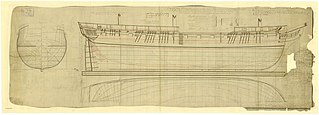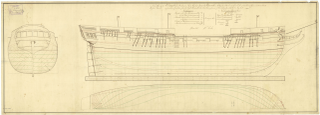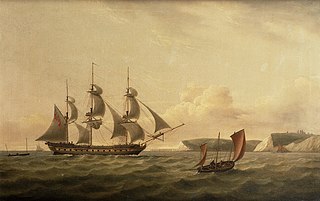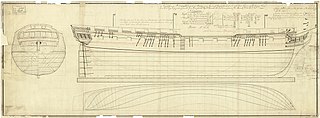
HMS Leander was a 50-gun spar-decked frigate of the Royal Navy which saw service in the Napoleonic Wars, the War of 1812, and the Second Barbary War.

HMS Saldanha was a 36-gun fifth-rate Apollo-class frigate of the Royal Navy. She was commissioned in April 1810 and spent her entire career serving on the Irish Station, including capturing a fast-sailing French privateer on 11 October 1811. In the evening of 4 December that year Saldanha was serving off Lough Swilly when she was caught in a storm. Last seen sailing off Fanad Head, the ship was wrecked in a nearby bay with every person on board being killed and the only survivors being a parrot and a dog. The wreck was memorialised by Thomas Sheridan in his poem The Loss of the Saldanha.

HMS Galatea was an Apollo-class fifth rate of the Royal Navy. The frigate was built at Deptford Dockyard, London, England and launched on 31 August 1810. In 1811 she participated in the Battle of Tamatave, which battle confirmed British dominance of the seas east of the Cape of Good Hope for the rest of the Napoleonic Wars. She was hulked in 1836 and broken up in 1849.
The Apollo-class sailing frigates were a series of twenty-seven ships that the British Admiralty commissioned be built to a 1798 design by Sir William Rule. Twenty-five served in the Royal Navy during the Napoleonic Wars, two being launched too late.
HMS Weymouth was a 44-gun fifth rate of the Royal Navy. She was previously the merchantman Wellesley, built in Calcutta in 1796. She successfully defended herself against a French frigate, and made two voyages to Britain as an East Indiaman for the East India Company. The Admiralty purchased her in May 1804; she then became a storeship in 1806. On her last voyage for the Royal Navy, in 1820, she carried settlers to South Africa. She was then laid up in ordinary. In 1828, she was converted to a prison ship and sailed to Bermuda where she served as a prison hulk until 1865 when she was sold for breaking up.

HMS Pallas was one of the three 36-gun Venus-class fifth-rate frigates of the Royal Navy. She was launched in 1757 and initially served in Sir Edward Hawke's fleet blockading the coast of France where she fought at the Raid on Cherbourg and in the Battle of Bishops Court. She later served for a number of years in the Mediterranean Sea before moving to serve off the coast of Africa between 1774 and 1776 where she protected the isolated British colonies. In 1778 she joined the Newfoundland Station and participated in the attack on Saint Pierre and Miquelon. Pallas returned to the English Channel after this and assisted in destroying a French invasion force intended for the Channel Islands in 1779 before briefly serving on the Jamaica Station. In 1783 she was beached on São Jorge Island after she was found to be heavily leaking; she was burned there on 24 February.
William Pitt was a three-decker sailing ship, built in Liverpool in 1803. She made three complete voyages for the British East India Company (EIC), and on the first of these she transported convicts to New South Wales. In December 1813 she was lost in a gale to the east of Algoa Bay while homeward bound from her fourth voyage.

HMS Aigle was a 36-gun, fifth-rate frigate of the Royal Navy. Ordered on 15 September 1799 and built at Bucklers Hard shipyard, she was launched 23 September 1801. More than fifty of her crew were involved in the Easton Massacre when she visited Portland in April 1803 to press recruits. Her captain and three other officers stood trial for murder but were acquitted. Much of Aigle's career as a frigate was spent trying to keep the English Channel free of enemy warships and merchant vessels. On 22 March 1808, she was first into the action against two large French frigates, compelling one to seek the shelter of the Île de Groix batteries and forcing the other onto the shore.

The Thames-class frigate was a 32-gun fifth-rate frigate class of eight ships of the Royal Navy based on the Richmond-class frigate designed by William Bately. The ships were ordered to the older design, which was of a smaller type of ship compared to more modern designs, so that they could be built quickly and cheaply in time to assist in defending against Napoleon's expected invasion of Britain. The class received several design changes to the Richmond class, being built of fir instead of oak, with these changes making the class generally slower and less weatherly than their predecessors, especially when in heavy weather conditions. The first two ships of the class, Pallas and Circe, were ordered on 16 March 1804 with two more ordered on 1 May and the final four on 12 July. The final ship of the class, Medea, was cancelled on 22 October before construction could begin but the other seven ships of the class were commissioned between 1804 and 1806.
Admiral Sir Robert Howe Bromley, 3rd Baronet was a Royal Navy officer of the eighteenth and nineteenth centuries. After joining the navy in 1791 under the auspices of his relative Captain Henry Curzon, he participated in the Macartney Embassy to China as a midshipman and also spent time serving in the English Channel and Mediterranean Sea. Promoted to lieutenant in 1798, he served in the North Sea Fleet and on the Jamaica Station before returning to the Channel to serve off the Channel Islands in the sloop of war HMS Pelican which was heavily damaged in a storm in late 1800. Soon after this he was promoted to commander and again served in the North Sea, before being promoted to post captain in 1802.

HMS Seringapatam was a 46-gun Seringapatam-class fifth-rate frigate built for the Royal Navy between 1817 and 1821, the name ship of her class.
HMS Thames was a 32-gun fifth-rate Thames-class frigate of the Royal Navy, launched in 1805 at Chatham.

HMS Jason was a 36-gun fifth-rate Penelope-class frigate, launched in 1800. She served the entirety of her career in the English Channel, mostly in the frigate squadron of Commodore Charles Cunningham. Serving off the coast of France, especially around Le Havre and Cherbourg, she captured several French privateers and recaptured a British merchant ship in a cutting out expedition. Having only been in commission for around fifteen months, Jason was wrecked off the coast of St Malo on 21 July 1801. Her crew were saved and later exchanged, and in August her wreck was burned to prevent the French from rescuing it.

HMS Hussar was a 38-gun fifth-rate Amazon-class frigate of the Royal Navy. Launched at the end of 1799, the entirety of the frigate's career was spent serving in the English Channel and off the coast of Spain. Hussar primarily served as a convoy escort and cruiser, in which occupation the frigate took several prizes, including the French privateer Le General Bessieres. Towards the end of 1803 Hussar was sent to serve in Sir Edward Pellew's Ferrol squadron. On 8 February 1804 Hussar was returning to England with dispatches when the ship was wrecked off the coast of Île de Sein. The crew attempted to sail for home in a fleet of commandeered boats, but the majority were forced to go into Brest to avoid sinking in bad weather, where they were made prisoners of war.

The Perseverance-class frigate was a 36-gun, later 42-gun, 18-pounder fifth-rate frigate class of twelve ships of the Royal Navy, constructed in two batches. Designed by Surveyor of the Navy Sir Edward Hunt the first iteration, consisting of four ships, was constructed as a rival to the similar Flora-class frigate. Strongly built ships, the Perseverance class provided favourable gunnery characteristics and was highly manoeuvrable, but bought these traits with a loss of speed. The name ship of the class, Perseverance, was ordered in 1779 and participated in the American Revolutionary War, but her three sister ships were constructed too late to take part. The class continued in service after the war, but soon became outdated.

The Narcissus-class frigate was a 32-gun, 18-pounder fifth-rate frigate class of five ships of the Royal Navy. Designed by Surveyor of the Navy Sir John Henslow, the class was created to make use of shipyards that could not construct larger frigates. They were similar in design to the preceding 32-gun frigate class, the Amphion class, but were slightly shorter. Two ships were initially constructed, with a later batch of three being ordered in response to an Admiralty request for the resumption of production of proven frigate designs. The final two ships of the class were cancelled when the shipyard they were being constructed at went bankrupt. Unlike her sister ships, the name ship of the class Narcissus was armed with experimental short 24 pounders rather than 18 pounders.

Aigle-class frigates were 36-gun sailing frigates of the fifth rate designed by Surveyor of the Navy, Sir John Henslow for the Royal Navy. Only two were built: HMS Aigle and HMS Resistance. Aigle was ordered first on 15 September 1798 but a 16-month delay during her construction meant that Resistance was completed and launched first on 29 April 1801.
Vice-Admiral Philip Wodehouse was a Royal Navy officer. A son of John Wodehouse, 1st Baron Wodehouse, he joined the navy some time before 1794. In 1796 he was promoted to commander and then captain, commanding sloops and frigates in the Mediterranean Fleet. Wodehouse cycled through a series of frigate commands towards the end of the French Revolutionary Wars, including HMS Mignonne which he had to burn as useless in 1797. In 1803, while commanding HMS Resistance, his ship was wrecked off Cape St Vincent. Wodehouse subsequently commanded several ships of the line, including HMS Cumberland in the Mediterranean where in 1809 he fought at the Battle of Maguelone. Wodehouse was appointed Resident Commissioner, Halifax, in 1811 and served there until the dockyard was closed in 1819. He was promoted to rear-admiral later in the year. Wodehouse saw no further active service, but was promoted to vice-admiral in 1830.

HMS Pallas was a 36-gun fifth-rate Apollo-class frigate of the Royal Navy. Placed in ordinary when completed in 1816, Pallas was commissioned for the first time in 1828. Under Captain Adolphus FitzClarence the frigate spent time blockading the Azores before making trips to India and then Nova Scotia, conveying important passengers. The ship sailed to the Mediterranean in 1830 under the command of Captain Manley Hall Dixon, and returned early the following year with the survivors of the wreck of the Countess of Harcourt. Later in the year Pallas joined the West Indies Station, where she served until 1834 when she was paid off. In 1836 the frigate was converted into a coal hulk, in which role she served at Plymouth Dockyard until being sold in 1862.












